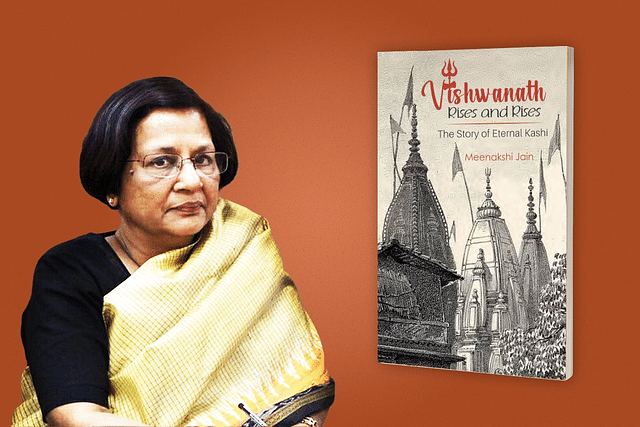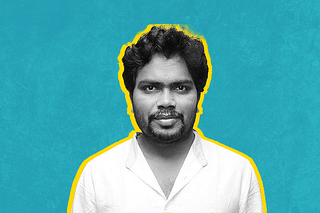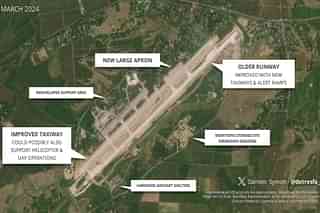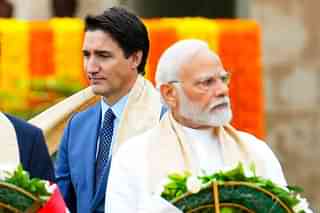Books
Historian Meenakshi Jain Does It Again; Ayodhya, Mathura And Now Kashi
R Jagannathan
Mar 07, 2024, 11:54 AM | Updated Mar 08, 2024, 05:02 PM IST
Save & read from anywhere!
Bookmark stories for easy access on any device or the Swarajya app.

Vishwanath Rises and Rises: The Story of Eternal Kashi. Meenakshi Jain. Aryan Books. 2024. Pages 294. Price Rs 995.
Some authors set out to deliberately write trilogies; others find they are drawn into writing them because their earlier efforts seemed incomplete without them.
Meenakshi Jain, one of India’s most understated but impactful historians, belongs to the latter category. She hit the high notes with her brilliant work on Rama and Ayodhya in 2013, which essentially made a historical case for the Ram Temple in place of the Babri Masjid.
The temple was inaugurated this January by Prime Minister Narendra Modi after a favourable court verdict in 2019. The Ayodhya book was followed — though there were other notable books coming in-between — by Vasudeva Krishna and Mathura in 2021, which effectively pointed Jain in the direction of Kashi, the holiest of holy Hindu places.
Kashi is one of the oldest inhabited cities on the planet with huge linkages to Hindu civilisational heritage. It is currently the scene of a court battle between Hindu groups which want to reclaim it for themselves amid stiff resistance from Muslims who want their “GyanVapi” mosque to remain where it is.
Jain’s latest book, Vishwanath Rises and Rises: The Story of Eternal Kashi, provides a historian’s perspective on the antiquity of the city and its importance to Hindus. If full possession of the site is to be decided on the basis of historical evidence alone, the Hindu side will surely have the last word on this issue.
We all know that the Kashi Vishwanath Mandir was demolished on the orders of Aurangzeb in 1669, but Jain points out that the desecration of Kashi goes much further back to earlier Islamic depredations.
The first recorded attack was by a son of Mahmud of Ghaznavi, which did not quite impact the key temples, but the following one by Qutbuddin Aibak in the 12th century CE, and the next one more than three centuries later by Sikandar Lodi, made no bones about the need to destroy kafir icons. Aurangzeb’s was only the third major desecration.
In a saner world, one would recommend Jain’s book not only to those battling in the courts, but to today’s Muslims, who have been fed lies on Islamic destruction of Hindu and Buddhist places of worship in their iconoclastic zeal.
But Hindus too should read it, too, not only to confirm what they have already suspected, but for the sheer sweep of scholarship that Jain has brought to bear in this book. No Hindu will come away from the book without acknowledging some nugget of information he knew nothing about.
Eminently readable and divided into 21 short chapters, Vishwanath Rise and Rises traces the history of Kashi not just from mediaeval times, but much earlier.
Chapter 3, "Rediscovering Ancient Kashi", tells us how the earliest settlements were traced at least as far back as the 18th or 19th centuries BCE, which takes it back to the later Vedic age.
The grammarian Panini talked about Kashi janapada, where the janapada was described both as a state and a cultural entity, with “culture counting (for) more than its geography”.
One can, arguably, attribute the idea of India that is Bharat as a civilisational entity that is not just defined by its geography from this description of the Kashi janapada.
A city closely identified with Mahadeva, Lord Shiva, Jain’s book reiterates the folklore and scriptural references to Kashi as the holiest of holy places on earth, with anyone dying there achieving moksha. The story of Ganga’s descent and Lord Shiva’s role in cushioning its impact are part of this story.
The Buddha, who attained parinibbana in Kushinagar, was also advised that he should have chosen some of the greater cities, including Varanasi, to breathe his last. Jain’s first seven chapters deal with the rise and rise of Kashi as one of the holiest cities in ancient India.
Kashi attained pre-eminence in the Puranic age, with the Skanda Purana (dated to 6th or 7th century CE) serving as its most expansive scripture.
The threats to Kashi began with the advent of Muslim incursions, and its economic decline began in the 11th and 12th centuries, which continued till the 18th century.
The temple that was destroyed by Aurangzeb was built during the time of Akbar by his revenue minister, Todar Mal, and Narayana Bhatta. Chapters 10 and 12 are particularly worth a read, for they show how Hindus never gave up and continued building and rebuilding their temples in Kashi despite Islamic destructiveness.
This continued right till the rise of the Marathas, with the current Kashi Vishwanath temple being built by Ahilyabai Holkar. The Marathas under the Peshwas were particularly devoted to restoring Kashi to its Hindu ownership.
The repeated attempts to build temples in Kashi shows how the community never gave in to pessimism and victimhood narratives in the worst of situations. It also explains the title of Jain’s book, on how eternal Kashi has risen repeatedly from the ashes.
It will do so once again, perhaps through a court battle or a compromise solution with Muslims.
Jain, in Vishwanath Rises and Rises, once again demonstrates the power of good research and scholarship, something clearly missing in the fake narratives put out by Leftist historians such as Romila Thapar and Irfan Habib. Vishwanath Rises and Rises is a must for your bookshelf.
Save & read from anywhere!
Bookmark stories for easy access on any device or the Swarajya app.
Jagannathan is Editorial Director, Swarajya. He tweets at @TheJaggi.
Introducing ElectionsHQ + 50 Ground Reports Project
The 2024 elections might seem easy to guess, but there are some important questions that shouldn't be missed.
Do freebies still sway voters? Do people prioritise infrastructure when voting? How will Punjab vote?
The answers to these questions provide great insights into where we, as a country, are headed in the years to come.
Swarajya is starting a project with an aim to do 50 solid ground stories and a smart commentary service on WhatsApp, a one-of-a-kind. We'd love your support during this election season.
Click below to contribute.





